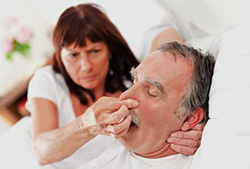Sleep apnea and other types of sleep disordered breathing including snoring need to be taken seriously.
In children sleep apnea, snoring and upper airways resistance syndrome are known to contribute to lower IQ, ADHD and other types of learning and behavioral issues(Bonuck, Freeman et al. 2012).
In adults sleep apnea and milder form of sleep disordered breathing such as upper airways resistance syndrome can cause insomnia, un-restful sleep, daytime fatigue and increase the risk for heart disease, hypertension, depression, dementia, cancer, weight gain and diabetes.
Recent research has been linking even mild forms of sleep disordered breathing to fibromyalgia, chronic fatigue syndrome and other so called functional somatic syndromes(Gold, Dipalo et al. 2003).
Sleep apnea also increases the severity of asthma and COPD symptoms. People who have difficulty controlling asthma attacks or who have night time asthma are more likely to have sleep apnea. (Teodorescu, Polomis et al. 2013).
CPAP is considered to be the treatment of choice, medically speaking but the reality is that it does not suit many people for various reasons. Oral devices that alter the position of the jaw and tongue also can be very helpful for some people but do not suit others.


Breathing and muscle exercises for sleep apnea and sleep disordered breathing
Breathing, tongue and throat exercises can be very helpful for snoring and for sleep apnea and in some cases can be an important part of treatment success (Guilleminault, Huang et al. 2013). These can be used in conjunction with things like weight loss, oral devices and treatments such as CPAP to improve treatment outcomes. Research has shown that in some people with mild to moderate sleep apnea they can significantly reduce the severity and symptoms of both snoring and sleep apnea (Guimarães, Drager et al. 2009).
In children with sleep apnea breathing and throat exercises can be an important part of rehabilitation if removal of adenoids and tonsils do not result in a complete cure (Villa, Brasili et al. 2015)
Throat and tongue exercises
The muscles of the throat and the tongue can play an important role in the quality of breathing during sleep. Like any other muscle, the muscles of the throat and tongue relaxes while you sleep, which is fine as long as you have a good sized airway, normal tongue posture and good muscle tone in the muscles that attach to the tongue and surround the airway.
These muscles can be trained so that the throat and airway stays open during the deeper stages of sleep. Research shows that practicing tongue and throat exercises for about 30 minutes per day over 3 moths can reduce snoring and sleep apnea by as much as 40% (Guimarães, Drager et al. 2009).
Breathing therapies
Abnormal breathing including mouth breathing and breathing patterns that reflect unstable breathing control can contribute to all types of sleep apnea (Kim, Choi et al. 2010).
When we breathe in through the mouth, the shape of the upper airway changes. It becomes more elongated and more collapsible. The air hits the back of the throat with greater force and this leads to more vibrations in the soft tissue. These vibrations are the sounds of snoring. Open-mouth breathing during sleep is an important risk factor for obstructive sleep apnea (OSA), associated with increased disease severity related to increased upper airway collapsibility (Lavie 1987).
Breathing through your nose helps to maintain your airway tone and stops tongue from falling backwards at night while you sleep.
Breathing exercises that help you to learn how to breathe through your nose and improve the efficiency and stability of daytime breathing can be an important part of an overall treatment plan for snoring and sleep apnea .
One study was even able to show that regular practice playing the didgeridoo for 4 months significantly improved snoring, sleep apnea scores and health related quality of life in 24 individuals who started out with moderately severe sleep apnea.
The following table shows the results of 12 months of breathing training with the Buteyko Method in three individuals with severe sleep apnea who had sleep studies before and after practicing the breathing exercises for 12 months (Birch 2012).
| Apnea-Hypopnea Index – Before |
Apnea-Hypopnea Index – After |
Apneas
Before |
Apneas
After |
Hypopneas
Before |
Hypopneas
After |
|
| Male
Age 56 |
40- severe | 6- normal | 189 | 13 | 103 | 22 |
| Female
Age 54 |
68-severe | 2-normal | 60 | 0 | 8.4 | 8 |
| Male
Age 52 |
28 -moderate | 4-normal | 136 | 4 | Not recorded | 16 |
In all cases of sleep apnea it is important to base treatment on proper diagnosis and to monitor the results of treatment to make sure that it is in fact being improved by what ever combination of therapies is used.
References
- Birch, M. (2012). Sleep apnoea and breathing retraining, Buteyko Institute of Breathing and Health.
- Bonuck, K., K. Freeman, R. D. Chervin and L. Xu (2012). “Sleep-disordered breathing in a population based cohort: behavioural outcomes at 4 and 7 years.” Pediatrics 129(4): 1-9.
- Gold, A. R., F. Dipalo, M. S. Gold and D. O’Hearn (2003). “The symptoms and signs of upper airway resistance syndrome: a link to the functional somatic syndromes.” Chest 123(1): 87-95.
- Guilleminault, C., Y. S. Huang, P. J. Monteyrol, R. Sato, S. Quo and C. H. Lin (2013). “Critical role of myofascial reeducation in pediatric sleep-disordered breathing.” Sleep Med 14(6): 518-525.
- Guimarães, K. C., L. F. Drager, P. R. Genta, B. F. Marcondes and G. Lorenzi-Filho (2009). “Effects of oropharyngeal exercises on patients with moderate obstructive sleep apnea syndrome.” Am J Respir Crit Care Med 179(10): 962-966.
- Kim, E. J., J. H. Choi, K. W. Kim, T. H. Kim, S. H. Lee, H. M. Lee, C. Shin, K. Y. Lee and S. H. Lee (2010). “The impacts of open-mouth breathing on upper airway space in obstructive sleep apnea: 3-D MDCT analysis.” Eur Arch Otorhinology Ahead of print.
- Lavie, P. (1987). “Rediscovering the importance of nasal breathing during sleep or, shut your mouth and save your sleep.” J Laryngol Otol. 101(6): 558-563.
- Teodorescu, M., D. A. Polomis, R. E. Gangnon, J. E. Fedie, F. B. Consens, R. D. Chervin and M. C. Teodorescu (2013). “Asthma Control and Its Relationship with Obstructive Sleep Apnea (OSA) in Older Adults.” Sleep Disord 2013: 251567.
- Villa, M. P., L. Brasili, A. Ferretti, O. Vitelli, J. Rabasco, A. R. Mazzotta, N. Pietropaoli and S. Martella (2015). “Oropharyngeal exercises to reduce symptoms of OSA after AT.” Sleep Breath 19(1): 281-289.
Breathing programs
These programs teach adults/children with snoring and sleep apnea how to improve their breathing, throat and tongue function as part of an overall management plan.
